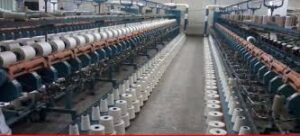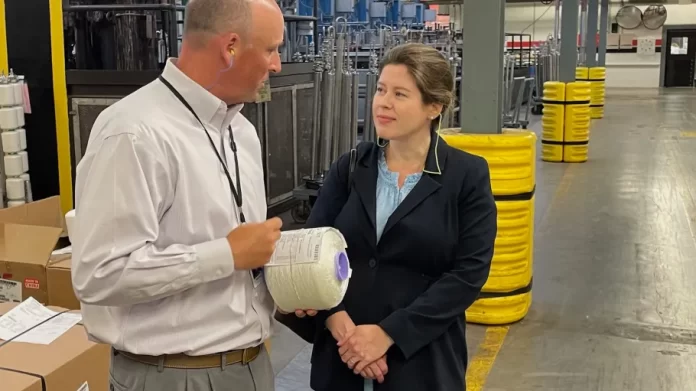Weaving the Future: How Textile Titan Katie White Tackles Trade Challenges and Tech Innovations in North Carolina
Textile Titan Katie White Faces Trade Challenges: Insights from her North Carolina Visit
Greetings, textile aficionados and tech enthusiasts!** This week, we delve into the world of trade policies, textile innovations, and the future of the domestic textile industry. At the heart of this discussion is the recent North Carolina visit by Katherine “Katie” White, the newly appointed chief textiles and apparel negotiator for the Office of the U.S. Trade Representative (USTR).
Katie White, with an impressive track record as an International Trade Policy Advisor on the House Committee on Ways and Means, has now stepped into her role at the USTR. Her inaugural visit to North Carolina, a key state in the American textile sector, underscores the keen interest of the current administration in addressing the pressing issues faced by domestic textile manufacturers.
During her visit, White toured six prominent textile plants, including American & Efird, Parkdale Mills/U.S. Cotton, TSG Finishing, Shuford Yarns, Schneider Mills, and Unifi. This boots-on-the-ground approach enabled her to witness firsthand the cutting-edge advancements and contributions of the U.S. textile industry.
Unpacking the Significance of This Visit
Her visits to these facilities were not mere ceremonial tours. For instance, American & Efird, known for producing high-performance industrial sewing thread, thread-like products, and technical textiles, exemplifies the advanced manufacturing capabilities of the U.S. textile industry. These facilities are not just production hubs; they are centers of innovation, constantly evolving to meet new challenges and demands, particularly those placed upon them by the U.S. military which relies on this sector for over 8,000 products annually.
The fact that White began her tenure with such an immersive experience stands as a testament to the administration’s commitment to devising trade policies that support and enhance the domestic textile industry. The industry is not just about producing fabrics but involves providing essential personal protective equipment (PPE) crucial for national health and safety, especially spotlighted during global health crises like the COVID-19 pandemic.
Textile Industry’s Challenges and Opportunities
The discussions held at Gaston College’s Textile Center during a roundtable meeting revealed much about the current landscape of the industry. Executives highlighted the sector’s innovative spirit and its significant economic contributions, but they also pointed out the “severe economic headwinds” they are facing. These include predatory trade practices from foreign entities and insufficient enforcement of trade laws, which threaten the industry’s robustness.

In 2023, the U.S. textile industry reported a whopping $64.8 billion output and employed around 500,000 workers. Yet, these impressive figures are overshadowed by the ongoing battle with unfair trade practices mainly attributed to international competitors, notably China. The issue of predatory pricing and practices is a thorny one, leading voices in the industry, like Kim Glas, president and CEO of the National Council of Textile Organizations (NCTO), to call for stringent actions.
NCTO members urged White to take decisive measures such as raising Section 301 tariffs on imported finished textiles and apparel from China. A major point of contention is the de minimis loophole, which allows for small shipments to enter the U.S. duty-free if they are valued below a specific threshold. Given the voluminous nature of textile imports, this can result in significant losses to domestic producers.
Policies That Shape the Future
The textile industry’s plea for support extends beyond just trade protection. They have emphasized maintaining the “yarn forward rule of origin,” which mandates that yarn used in textiles must be sourced from within the United States or designated partner countries to qualify for tariff benefits. Industries argued for stepped-up customs enforcement and effective penalties for trade agreement violations.
Another crucial area discussed was the expansion of the Western Hemisphere co-production chain, a move intended to strengthen trade relationships with neighboring countries, ensuring better resilience and competitiveness. The Berry Amendment, a statutory requirement that mandates the Pentagon to give preference to domestically produced goods, was also extolled for its potential to foster investment, boost local production, and secure jobs.
The Technological Edge and Future Prospects
While the visit was mostly about addressing current challenges, it was equally about looking forward. At the heart of textile innovations lies the realm of technical and smart textiles—a burgeoning field that has the potential to propel the industry into a new era of growth.
Smart Textiles** are fabrics integrated with technologies that provide value-added functionalities. Think of them as fabrics that can interact with their environment, react to stimuli such as electrical, thermal, or magnetic changes, and even store energy or monitor health conditions. This field stretches the traditional boundaries of textiles into domains like wearable technology, where fabrics could monitor physical conditions or provide computing power on the go—concepts that were once limited to science fiction.
These innovations necessitate complex manufacturing processes and the integration of advanced materials. For example,
Conductive Yarns**, which are used in smart textiles to carry electrical signals, are created by infusing traditional fibers with metals like silver or incorporating conductive polymers.
White’s interaction with these advanced manufacturing enterprises showcases how integral innovation is in securing a future where the U.S. continues to lead in textile manufacturing. It’s not just about producing more but about producing smarter, leveraging technology to maintain a competitive edge on the global stage.
Closing Thoughts
Katie White’s visit to North Carolina signified more than just a routine inspection. It was a strong message to the industry that change is on the horizon. The textile industry, with its rich history and transformative innovations, is at a “pivotal time,” to borrow the terms of the NCTO. With robust policies, technological advancements, and a collaborative spirit between government and industry players, the domestic textile sector is poised to overcome current challenges and write new success stories.
For textile enthusiasts and industry leaders following this development, it is clear that the commitment to fostering a fair and resilient supply chain is unwavering. The perfect weave of policy support, technological innovation, and community spirit can ensure that the U.S. textile industry not only survives but thrives in the years to come.
Keep your looms humming and your tech tuned in because this fusion of textiles and technology is crafting a future rich in potential and innovation. Until next time, stay threaded into the fabric of the textile industry with Textile Topher!
Keywords: Trade Policies, Textile Innovations, Smart Textiles, (Post number: 3), Predatory Trade Practices, Domestic Manufacturing





